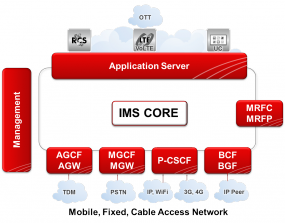When it comes to communications, a standardized piece of multimedia architecture for next generation networks is the Internet (IP) Multimedia Subsystem or IMS. IMS is a VoIP implementation that runs over the internet protocol. Telecom operators use IP Multimedia Subsystem to combine voice and data into a single packet switched network in new generation networks so that controlled multimedia services can be offered. IMS is operator friendly for fixed and mobile IP services.
The standards for IMS give real time packet calls and services to preserve a carrier’s traditional controls over user usage-based billing and signaling while generating new revenue through deep packet inspection of content, URI and protocols. As the interest in data applications, the internet, and wireless internet grew from telephony carriers, IMS became the result.
With the continuous new services IMS provides current and future internet services so that no matter where a user is or on what type of device the execution of all their services is available. By using open standard IP protocols, a multimedia session between two Internet Multimedia Subsystem users or an IMS user and an internet user, or two internet users can be established using the same protocol. Interfaces for developers are also based in internet protocols. IMS merges the cellular world with the internet by using cellular technologies to access and provide appealing services.
The next generation networks where IMS is based utilized SIP (Session Initiation Protocol) with extensions to create a telephony-oriented signaling network that replaces legacy signaling, acting like a wireless control plane. There are a number of SIP proxy servers conciliate user/customer connections that make up an IMS network so that they have access to the resources. IMS presumes that each user is affiliated with a “home” network and supports, just as with cellular networks, roaming across cabled and wireless networks. There is authentication and a policy engine with IP Multimedia Subsystem, as well as, operator control and security with authorization and accounting server.
In order to gain advantage in the market or to avoid vendor lock, operators may need to have an IMS solution. Some IMS deployments may need improvement in reliability, global services, scale, and innovation. By choosing the right network elements form the right vendor for IP-centric voice and multimedia solutions operators can rest assured they have the best in class IMS network elements.
Mobile and fixed operators are able to monetize services through rapid delivery ov multimedia and voice applications. This can include high definition video and voice, call logs, and address books, as well as, instant messaging to other networks.
Some network vendors provide a flexible approach to IMS that enables fixed and mobile operators to monetize services. This can be done by allowing a quick delivery of voice and multimedia applications. This can include RCS, enhanced RCS, high definition video and voice, instant messaging to other networks, and network based call logs and address books, and personalization via web-based user portals.

